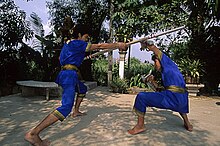Krabi Krabong

Krabi-krabong practitioners in Thailand
|
|
| Focus | Weaponry |
|---|---|
| Country of origin |
|
| Olympic sport | No |
| Meaning | Sword-staff |
Krabi-krabong (Thai: กระบี่กระบอง, Thai pronunciation: [krabìː krabɔ̄ːŋ]) is a weapon-based martial art from Thailand. It is closely related to other Southeast Asian fighting styles such as Malay silat, Burmese banshay and Cambodian kbach kun boran. The royal bodyguard corps of the late King Bhumibol Adulyadej (Rama IX) were said to be highly trained in krabi-krabong.
The system's name refers to its main weapons, namely the curved sword (krabi) and staff (krabong). Typically, two swords are wielded as a pair. Unarmed krabi-krabong (muay boran) makes use of kicks, pressure point strikes, joint locks, holds, and throws.
The weapons of krabi-krabong include the following:
Krabi-krabong was developed by the ancient Siamese warriors for fighting on the battlefield. It was likely used in conjunction with muay boran but whether the two arts were developed together or independently is uncertain. Early warfare in Indochina was mostly between rival kingdoms and were fought en masse. Individual fighters were armoured and carried rhino hide shields. The Burmese invasion of 1767 resulted in the loss of many historical records and cultural documents. Among these are known to have been works on muay boran, massage, swordsmanship and club-fighting. As a result, aspects of earlier Siamese history - including the country's fighting systems - must often be gleaned from elsewhere.
Archaeological findings and classical dances bear testament to the myriad of weapons that were once used in Thailand. Some of them are no longer found in the country's martial arts today, such as the kris (dagger), hawk (spear), trisul (either long or short-handled trident), daab (straight sword) and vajra. Entire dances were built on individual weapons, and calisthenics used by the modern Thai military are still based on these dances.
...
Wikipedia
